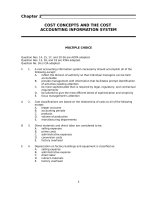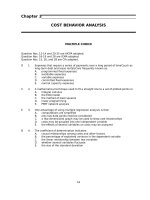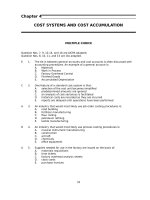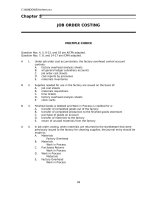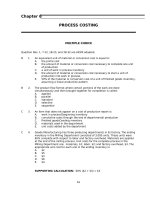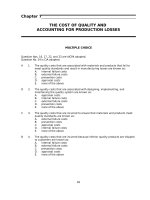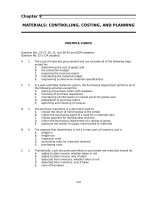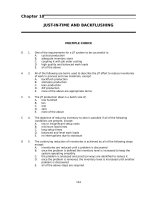Test bank cost accounting 6e by usry 13 factory overhead departmentaliation
Bạn đang xem bản rút gọn của tài liệu. Xem và tải ngay bản đầy đủ của tài liệu tại đây (139.66 KB, 25 trang )
Chapter 13
FACTORY OVERHEAD: DEPARTMENTALIZATION
MULTIPLE CHOICE
Question Nos. 10, 11-14, and 26 are AICPA adapted.
Question Nos. 15-28 and 23-25 are CIA adapted.
C
1.
A department that would be classified as a producing department is:
A.
Production Control
B.
Utilities
C.
Finishing
D.
Medical
E.
Shipping
B
2.
A department that would be classified as a service department is:
A.
Refining
B.
Receiving
C.
Mixing
D.
Assembly
E.
Finishing
A
3.
In determining the right method for allocating equipment depreciation to departments, the
best recommendation is to:
A.
use the cost of equipment in the department as a basis for allocation
B.
allocate on the basis of square footage used in a given department
C.
charge the amounts to General Plant
D.
use algebraic techniques
E.
allocate on the basis of companywide rates
A
4.
The most reasonable basis for allocating worker's compensation insurance is:
A.
departmental payroll
B.
building depreciation
C.
kilowatt-hours
D.
number of employees
E.
materials used
E
5.
A company is attempting to allocate the costs of electricity in various departments. The
variable portion of electricity expense is to be allocated using kilowatt-hours. The
information needed in order to allocate the fixed portion of the current period's electricity
expense is:
A.
rated horsepower of equipment
B.
number of machines in each department
C.
estimated materials consumption
D.
number of employees
E.
square footage in each department
172
173
Chapter 13
E
6.
The method for allocating service department costs that requires the least clerical work is:
A.
use of square footage in each department
B.
step method
C.
allocation to other service departments only
D.
simultaneous method
E.
direct method
E
7.
Rapid Falls Corp. has three producing departments, A, B, and C, with 50, 30, and 20
employees, respectively, in each department. Factory payroll costs other than direct labor are
accumulated in a Payroll Department account and are assigned to producing departments on
the basis of number of employees. The total payroll in each department was: A, $300,000; B,
$275,000; C, $325,000; and Payroll, $50,000. Other costs accumulated in the Payroll
Department amounted to $200,000. The amount of Payroll Department costs chargeable to
Department C is:
A.
$125,000
B.
$100,000
C.
$40,000
D.
$10,000
E.
$50,000
SUPPORTING CALCULATION:
$50,000 + $200,000
= $2,500 /employee _ 20 = $50,000
50 + 30 + 20
E
8.
The following statement that best describes cost allocation is:
A.
a company, as a general rule, should allocate indirect costs randomly or based on an
"ability-to-bear" criterion
B.
a company can affect total income the most strongly by using the algebraic method of
allocating indirect costs
C.
a company can maximize or minimize total company income by selecting different bases
on which to allocate indirect costs
D.
a company should select an allocation base to raise or lower reported income on given
products
E.
a company's total income will remain unchanged no matter how indirect costs are
allocated
Factory Overhead: Departmentalization
D
9.
174
Carmichael Manufacturing Company has two production departments (Fabrication and
Assembly) and three service departments (General Factory Administration, Factory
Maintenance, and Factory Cafeteria). A summary of the year's costs and other data for each
department prior to allocation of service department costs appears below.
Labor costs...............................................
Material costs..........................................
Overhead..................................................
Direct labor hours..................................
Number of employees............................
Square footage occupied.......................
(
(
(
(
(
(
(
(
Factory
Maintenance
$82,100
$65,000
$56,100
27,000
8
2,000
Fabrication
$1,950,000
$3,130,000
$1,650,000
562,500
280
88,000
Assembly
$ 2,050,000
$ 950,000
$ 1,850,000
437,500
200
72,000
General Factory
Administration
$90,000
--$70,000
31,000
12
1,750
Factory
Cafeteria
$87,000
$91,000
$62,000
42,000
20
4,800
The costs of the General Factory Administration Department, Factory Maintenance
Department, and Factory Cafeteria are allocated on the basis of direct labor hours, square
footage occupied, and number of employees, respectively. There are no manufacturing
overhead variances.
Assuming that Carmichael elects to distribute service department costs under the direct
method of cost allocation, the amount of Factory Maintenance Department costs that would
be allocated to the Fabrication Department is (round all final calculations to the nearest
dollar):
A.
$106,091
B.
$91,440
C.
$0
D.
$111,760
E.
none of the above
SUPPORTING CALCULATION:
)
)
)
)
)
)
)
)
175
Chapter 13
$82,100 + $65,000 + $56,100
= $1.27 _ 88,000 = $111,760
88,000 + 72,000
A
10.
Carmichael Manufacturing Company has two production departments (Fabrication and
Assembly) and three service departments (General Factory Administration, Factory
Maintenance, and Factory Cafeteria). A summary of the year's costs and other data for each
department prior to allocation of service department costs appears below.
Labor costs...............................................
Material costs..........................................
Overhead..................................................
Direct labor hours..................................
Number of employees............................
Square footage occupied.......................
(
(
(
(
(
(
(
(
Factory
Maintenance
$82,100
$65,000
$56,100
27,000
8
2,000
Fabrication
$1,950,000
$3,130,000
$1,650,000
562,500
280
88,000
Assembly
$2,050,000
950,000
$1,850,000
437,500
200
72,000
General Factory
Administration
$90,000
--$70,000
31,000
12
1,750
)
)
)
)
)
)
)
)
Factory
Cafeteria
$87,000
$91,000
$62,000
42,000
20
4,800
The costs of the General Factory Administration Department, Factory Maintenance
Department, and Factory Cafeteria are allocated on the basis of direct labor hours, square
footage occupied, and number of employees, respectively.
The amount of General Factory Administration Department costs that would be allocated
to the Assembly Department under the direct method is (round all final calculations to the
nearest dollar):
A.
$70,000
B.
$90,000
C.
$0
D.
$63,636
E.
none of the above
SUPPORTING CALCULATION:
Factory Overhead: Departmentalization
176
$90,000 + $70,000
= $.16 _ 437,500 = $70,000
562,500 + 437,500
B
11.
Carmichael Manufacturing Company has two production departments (Fabrication and
Assembly) and three service departments (General Factory Administration, Factory
Maintenance, and Factory Cafeteria). A summary of the year's costs and other data for each
department prior to allocation of service department costs appears below.
Labor costs...............................................
Material costs..........................................
Overhead..................................................
Direct labor hours..................................
Number of employees............................
Square footage occupied.......................
(
(
(
(
(
(
(
(
Factory
Maintenance
$82,100
$65,000
$56,100
27,000
8
2,000
Fabrication
$1,950,000
$3,130,000
$1,650,000
562,500
280
88,000
Assembly
$2,050,000
$950,000
$1,850,000
437,500
200
72,000
General Factory
Administration
$90,000
--$70,000
31,000
12
1,750
Factory
Cafeteria
$87,000
$91,000
$62,000
42,000
20
4,800
The costs of the General Factory Administration Department, Factory Maintenance
Department, and Factory Cafeteria are allocated on the basis of direct labor hours, square
footage occupied, and number of employees, respectively.
Assuming that Carmichael elects to distribute service department costs to other service
departments using the step method of cost allocation and that the order of distribution is
based on the dollar amount of costs originating in the service departments, how much of the
total Factory Cafeteria cost would be allocated to the Factory Maintenance Department?
(Round all final calculations to the nearest dollar.)
A.
$96,000
B.
$3,840
C.
$6,124
D.
$0
E.
none of the above
SUPPORTING CALCULATION:
)
)
)
)
)
)
)
)
177
Chapter 13
$87,000 + $91,000 + $62,000
= $480 / employee _ 8 = $3,840
280 + 200 + 12 + 8
B
12.
Carmichael Manufacturing Company has two production departments (Fabrication and
Assembly) and three service departments (General Factory Administration, Factory
Maintenance, and Factory Cafeteria). A summary of the year's costs and other data for each
department prior to allocation of service department costs appears below.
Labor costs...............................................
Material costs..........................................
Overhead..................................................
Direct labor hours..................................
Number of employees............................
Square footage occupied.......................
(
(
(
(
(
(
(
(
Factory
Maintenance
$82,100
$65,000
$56,100
27,000
8
2,000
Fabrication
$1,950,000
$3,130,000
$1,650,000
562,500
280
88,000
Assembly
$2,050,000
$950,000
$1,850,000
437,500
200
72,000
General Factory
Administration
$90,000
--$70,000
31,000
12
1,750
)
)
)
)
)
)
)
)
Factory
Cafeteria
$87,000
$91,000
$62,000
42,000
20
4,800
The costs of the General Factory Administration Department, Factory Maintenance
Department, and Factory Cafeteria are allocated on the basis of direct labor hours, square
footage occupied, and number of employees, respectively.
How much of the Factory Maintenance Department costs would be allocated to the
Factory Cafeteria under the step method, assuming that the order of distribution is based on
the dollar amount of costs originating in the service departments? (Round all final
calculations to the nearest dollar.)
A.
$148,910
B.
$0
C.
$5,787
D.
$5,856
E.
none of the above
SUPPORTING CALCULATION:
Factory Cafeteria costs.........................................................................................................
Factory Maintenance costs...................................................................................................
Factory Cafeteria already closed out.
$240,000
$203,300
Factory Overhead: Departmentalization
A
13.
178
Acie Company has two service departments and three production departments, each
producing a separate product. For a number of years, Acie has allocated the costs of the
service departments to the production departments on the basis of the annual sales dollars. In
a recent audit report, the internal auditor stated that the distribution of service department
costs on the basis of annual sales dollars would lead to serious inequities. It was recommended
that maintenance and engineering service hours be used as a better service cost allocation
basis. For illustration purposes, the following information was appended to the audit report:
Service Departments
Maintenance
Maintenance hours used......................................
Engineering hours used.......................................
Department direct costs.......................................
400
$12,000
(
(
(
(
(
Department C
200
400
$50,000
Department A
800
800
$80,000
Production Departments
Department B
200
400
$90,000
)
Engineering
400
$54,000
Using the simultaneous method, what would be the total Engineering Department cost after
allocation of interservice department costs, but before allocation to the Maintenance and
Production Departments?
A.
$60,000
B.
$57,000
C.
$12,000
D.
$54,000
E.
none of the above
SUPPORTING CALCULATION:
Maintenance
Engineering
E
E
.95E
E
= $12,000 + .2E
= $54,000 + .25M
= $54,000 + .25($12,000 + .2E)
= $54,000 + $3,000 + .05E
= $57,000
= $60,000
)
)
)
)
179
D
Chapter 13
14.
Acie Company has two service departments and three production departments, each
producing a separate product. For a number of years, Acie has allocated the costs of the
service departments to the production departments on the basis of the annual sales dollars. In
a recent audit report, the internal auditor stated that the distribution of service department
costs on the basis of annual sales dollars would lead to serious inequities. It was recommended
that maintenance and engineering service hours be used as a better service cost allocation
basis. For illustration purposes, the following information was appended to the audit report:
Service Departments
Maintenance
Maintenance hours used......................................
Engineering hours used.......................................
Department direct costs.......................................
400
$12,000
(
(
(
(
(
Department C
200
400
$50,000
Department A
800
800
$80,000
Production Departments
Department B
200
400
$90,000
)
Engineering
400
$54,000
Using the simultaneous method, what would be the total Maintenance Department cost after
allocation of interservice department costs, but before allocation to the Engineering and
Production Departments?
A.
$72,000
B.
$12,000
C.
$60,000
D.
$24,000
E.
none of the above
SUPPORTING CALCULATION:
Maintenance
Engineering
M
M
M
.95M
M
= $12,000 + .2E
= $54,000 + .25M
= $12,000 + .2E
= $12,000 + .2($54,000 + .25M)
= $12,000 + $10,800 + .05M
= $22,800
= $24,000
)
)
)
)
Factory Overhead: Departmentalization
C
15.
180
Acie Company has two service departments and three production departments, each
producing a separate product. For a number of years, Acie has allocated the costs of the
service departments to the production departments on the basis of the annual sales dollars. In
a recent audit report, the internal auditor stated that the distribution of service department
costs on the basis of annual sales dollars would lead to serious inequities. It was recommended
that maintenance and engineering service hours be used as a better service cost allocation
basis. For illustration purposes, the following information was appended to the audit report:
Service Departments
Maintenance
Maintenance hours used......................................
Engineering hours used.......................................
Department direct costs.......................................
400
$12,000
(
(
(
(
(
Department C
200
400
$50,000
Department A
800
800
$80,000
Production Departments
Department B
200
400
$90,000
)
Engineering
400
$54,000
)
)
)
)
Using the step method of cost allocation, what amount of maintenance cost would be allocated
to Department A, assuming that the service departments are distributed in the order of total
dollars of direct departmental costs?
A.
$0
B.
$25,500
C.
$15,200
D.
$3,187.50
E.
none of the above
SUPPORTING CALCULATION:
Maintenance = $12,000 + .2($54,000) = $22,800
Department A = 800/1,200 x $22,800 = $15,200
181
B
Chapter 13
16.
Acie Company has two service departments and three production departments, each
producing a separate product. For a number of years, Acie has allocated the costs of the
service departments to the production departments on the basis of the annual sales dollars. In
a recent audit report, the internal auditor stated that the distribution of service department
costs on the basis of annual sales dollars would lead to serious inequities. It was recommended
that maintenance and engineering service hours be used as a better service cost allocation
basis. For illustration purposes, the following information was appended to the audit report:
Service Departments
Maintenance
Maintenance hours used......................................
Engineering hours used.......................................
Department direct costs.......................................
(
(
(
(
(
Department A
800
800
$80,000
Production Departments
Department B
200
400
$90,000
400
$12,000
)
Engineering
400
$54,000
)
)
)
)
Department C
200
400
$50,000
Using the step method of cost allocation, what amount of engineering cost would be allocated
directly to Department A, assuming that the service departments are distributed in the order
of total dollars of direct departmental costs?
A.
$11,400
B.
$21,600
C.
$10,800
D.
$22,800
E.
none of the above
SUPPORTING CALCULATION:
800/2,000 x $54,000 = $21,600
E
17.
A factor to be considered in deciding the kinds of departments required for establishing
accurate departmental overhead rates with which to control costs is:
A.
location of operations, processes, and machinery
B.
responsibilities for production and costs
C.
number of departments or cost centers
D.
similarity of operations, procedures, and machinery in each department
E.
all of the above
E
18.
Services available for the benefit of producing departments and other service departments can
be organized by:
A.
establishing a separate service department for each function
B.
combining several functions into one department
C.
placing service costs in a department called "general factory cost pool"
D.
none of the above
E.
all of the above
Factory Overhead: Departmentalization
182
B
19.
Entities that have practiced departmentalization for many years, by grouping their activities
into categories such as occupancy, sales promotion, purchasing, and delivery are:
A.
hospitals
B.
retail stores
C.
banks
D.
insurance companies
E.
colleges
A
20.
An automotive company has three divisions. One division manufactures new replacement
parts for automobiles; another rebuilds engines; and the third does repair and overhaul work
on a line of trucks. All three divisions use the services of a central payroll department. The
best method of allocating the cost of the payroll department to the various operating divisions
is:
A.
total labor hours incurred in the divisions
B.
value of production in the divisions
C.
direct materials costs incurred in the divisions
D.
machine hours used in the divisions
E.
none of the above
B
21.
The Janitorial Department provides cleaning services to all departments of a large store.
Management wishes to allocate the janitorial costs to the various departments that benefit
from the service. The most reasonable allocation base for janitorial costs would be:
A.
sales of each department
B.
square footage of each department
C.
number of employees in each department
D.
total direct costs of each department before any allocations
E.
none of the above
C
22.
A hospital has a $100,000 expected utility bill this year. The Janitorial, Accounting, and
Orderlies Departments are service functions to the Operating, Hospital Rooms, and
Laboratories Departments. Floor space assigned to each department is:
Department........................................................................................................
Janitorial.............................................................................................................
Accounting.........................................................................................................
Orderlies.............................................................................................................
Operating............................................................................................................
Hospital Rooms.................................................................................................
Laboratories.......................................................................................................
...................................................................................................................
Square Footage
1,000
2,000
7,000
4,000
30,000
6,000
50,000
How much of the $100,000 will eventually become the Hospital Rooms Department total costs,
assuming use of the direct method of allocation based on square footage?
A.
$60,000
B.
$72,000
C.
$75,000
D.
$80,000
E.
none of the above
183
Chapter 13
SUPPORTING CALCULATION:
30,000
_ $100,000 = $75,000
40,000
C
23.
Serpent Corp. distributes service department overhead costs directly to producing
departments without allocation to the other service department. Information for the month
of June is as follows:
Service Departments
Maintenance
Utilities
Overhead costs incurred..........................................................
$20,000
$10,000
Service provided to department:
Maintenance.......................................................................
-10%
Utilities................................................................................
20%
-Producing—A....................................................................
40%
30%
Producing—B....................................................................
40%
60%
Totals...........................................................................................
100%
100%
The amount of Maintenance Department costs distributed to Producing—A Department for
June was:
A.
$8,000
B.
$8,800
C.
$10,000
D.
$11,000
E.
none of the above
SUPPORTING CALCULATION:
40%
_ $20,000 = $10,000
80%
D
24.
Multiple overhead rates are most commonly used when:
A.
production consists of long runs of a single product
B.
the company has more than one production department
C.
manufacturing operations are labor intensive
D.
production consists of a diverse product line
E.
none of the above
B
25.
An example of a nonvolume-related overhead base would be:
A.
direct materials cost
B.
number of setups
C.
machine hours
D.
direct labor dollars
E.
none of the above
Factory Overhead: Departmentalization
C
26.
An example of a department that would be a prime candidate for multiple overhead rates
would be one whose overhead was primarily:
A.
labor driven
B.
machine related
C.
caused by setups and production design changes
D.
materials related
E.
none of the above
184
185
Chapter 13
PROBLEMS
PROBLEM
1.
Overhead Allocation and Rates. To determine an overhead application rate for its Machining and
Assembly Departments, the management of Knight Co. requested the following overhead cost data for
June:
Item
Number of employees.................................................................
Square footage.............................................................................
Monthly average wage per employee
(direct and indirect)............................................................
Overhead directly chargeable to
department (excluding indirect labor)...........................
Materials used..............................................................................
Factory rent..................................................................................
Other building costs....................................................................
Payroll Department cost............................................................
Freight-in and other Receiving
Department costs................................................................
Machining
Department
60
15,000
Assembly
Department
40
10,000
Total
100
25,000
$ 2,000
$ 2,500
--
$ 90,000
60,000
?
?
?
$75,000
90,000
?
?
?
$165,000
150,000
33,000
60,000
18,000
?
?
75,000
In each department, 80% of the employees are direct laborers. Overhead is charged to production on the
basis of direct labor dollars. The allocation basis for other data is as follows: all building costs, square
footage; Payroll Department cost, number of employees; freight-in and other Receiving Department costs,
materials used.
Required:
(1)
(2)
Compute the total overhead chargeable to the Machining and Assembly Departments.
Compute the overhead application rate as a percentage of direct labor cost for each department.
(Round to the nearest whole percent.)
Factory Overhead: Departmentalization
186
SOLUTION
(1)
Machining
Department
Overhead directly chargeable............................................................................. $
90,000
Indirect labor:
20% x 60 x $2,000..........................................................................................
24,000
20% x 40 x $2,500..........................................................................................
Assembly
Department
$ 75,000
20,000
Factory rent:
15,000
$33,000 x ---------...........................................................................................
25,000
19,800
10,000
$33,000 x ---------...........................................................................................
25,000
Other building costs:
15,000
$60,000 x ---------...........................................................................................
25,000
13,200
36,000
10,000
$60,000 x ---------...........................................................................................
25,000
Payroll Department cost:
60
$18,000 x ------...............................................................................................
100
24,000
10,800
40
$18,000 x ------...............................................................................................
100
Freight-in and other Receiving Department costs:
$60,000
$75,000 x -----------........................................................................................
$150,000
$90,000
$75,000 x -----------........................................................................................
$150,000
Total overhead....................................................................................................... $
(2)
Direct labor costs:
80% x 60 x $2,000.......................................................................................... $
80% x 40 x $2,500..........................................................................................
Overhead as a percentage of direct labor cost:
$210,600/$96,000.............................................................................................
$184,400/$80,000............................................................................................
7,200
30,000
45,000
210,600
$ 184,400
96,000
$
80,000
219%
231%
187
Chapter 13
PROBLEM
2.
Overhead Application; Correction of Net Profit (or Loss). Pomeroy Printers Inc. uses job order costing.
Printers' wages are charged to direct labor, while typesetters' wages are charged to overhead and comprise
30% of applied overhead. Overhead is applied at the rate of 150% of direct labor cost. During July, only
two jobs were started and completed. Relevant data from these jobs were:
Item
Materials cost.........................................................................................................
Direct labor.............................................................................................................
Overhead applied..................................................................................................
Total cost of job..............................................................................................
Selling price............................................................................................................
Gross profit from job....................................................................................
Job 1776
$ 5,000
10,000
15,000
$ 30,000
30,000
$
0
Job 1865
$ 3,000
8,000
12,000
$ 23,000
35,000
$ 12,000
Management determines that the typesetters' wages should be a direct labor cost and that Job 1776
required 1/3 of the total typesetting cost incurred, while Job 1865 required 2/3.
Required:
(1)
(2)
(3)
Determine the total typesetters' wages for July.
Determine the corrected direct labor costs for Jobs 1776 and 1865.
Determine the correct gross profit (or loss) for each job. (Round the new overhead rate to the
nearest whole percent and the total overhead to the nearest dollar.)
SOLUTION
(1)
$8,100 [30% x ($15,000 + $12,000)]
(2)
Job 1776
$ 10,000
+
2,700 (1/3 x $8,100)
$ 12,700
Job 1865
$ 8,000
+ 5,400 (2/3 x $8,100)
$ 13,400
(3)
Item
Materials cost.........................................................................................................
Direct labor.............................................................................................................
Overhead applied 1.................................................................................................
Total cost of job..............................................................................................
Selling price............................................................................................................
Gross profit from job....................................................................................
Job 1776
$ 5,000
12,700
9,144
$ 26,844
30,000
$ 3,156
Job 1865
$
3,000
13,400
9,648
$ 26,048
35,000
$
8,952
Factory Overhead: Departmentalization
188
1
Total overhead
$18,900
=
= 72.41% or 72% overhead applied
Direct labor cost $12,700 + $13,400
PROBLEM
3.
Overhead Distribution Via Direct Method. Geo-trig Inc. has three producing departments (Sine, Cosine,
and Tangent) and two service departments (Rhombus and Triangle). Data that summarize overhead
activity for January are:
Sine
Producing Departments
Cosine
Tangent
Total overhead before service
department allocations..................... $50,000
Square footage
occupied...............................................
3,000
Number of employees...............................
50
Service Departments
Rhombus
Triangle
$80,000
$30,000
$40,000
$20,000
4,000
30
3,000
20
1,000
10
1,500
10
Rhombus costs are distributed on the basis of square footage occupied, while Triangle costs are distributed
on the basis of number of employees. The direct method is used for allocating service department costs to
producing departments.
Required: Prepare a schedule indicating the detailed components of overhead costs for the producing and
service departments, including the directly assigned and allocated overhead.
189
Chapter 13
SOLUTION
Sine
Producing Departments
Cosine
Tangent
Total overhead before service
department allocations..................... $50,000
Allocation of Rhombus costs:
(Base = square footage)
3,000
Sine: ---------- x $40,000.................... 12,000
10,000 1
Service Departments
Rhombus
Triangle
$ 80,000
$30,000
$40,000
--
--
(12,000)
$20,000
4,000
Cosine: --------- x $40,000.................
10,000
--
16,000
--
(16,000)
3,000
Tangent: --------- x $40,000..............
10,000
--
--
12,000
(12,000)
10,000
--
--
(10,000)
30
Cosine: ---- x $20,000........................
100
--
6,000
--
(6,000)
20
Tangent: ------ x $20,000...................
100
--
--
4,000
(4,000)
Total overhead........................................... $72,000
$102,000
$46,000
Allocation of Triangle costs:
(Base = number of employees)
50
Sine: ------ x $20,000.........................
100 2
Denominator =
or
2
Denominator =
or
1
3,000 + 4,000 + 3,000 = 10,000 square feet
30% + 40% + 30%
50 + 30 + 20 = 100 employees
50% + 30% + 20%
Factory Overhead: Departmentalization
190
PROBLEM
4.
Distribution of Direct and Indirect Overhead Costs to Producing Departments. Chaing Chemical Co.
operates with three producing departments—Blending, Testing, and Terminal. The overhead items and
amounts for the period, along with the bases for their allocation, are listed below.
Item
Building depreciation..........................................................................
Janitorial cost.......................................................................................
Materials receiving cost.......................................................................
Payroll Department cost.....................................................................
Power......................................................................................................
Amount
$ 24,000
33,000
48,000
126,000
75,000
Allocation Basis
Square footage
Square footage
Materials usage
Number of employees
Horsepower of equipment
Other relevant data are:
Number of employees.........................................
Direct labor hours...............................................
Horsepower of equipment.................................
Kilowatt-hours....................................................
Square footage.....................................................
Directly chargeable overhead cost...................
Direct materials...................................................
Blending
Department
25
62,000
60,000
4,000
2,000
$ 125,000
$ 75,000
Testing
Department
40
104,000
15,000
1,000
2,000
$ 75,000
$ 25,000
Terminal
Department
19
54,000
5,000
6,000
2,000
$87,500
--
Total
84
220,000
80,000
11,000
6,000
$287,500
$100,000
Required: Prepare the overhead distribution for each producing department, including the detail for each
item of allocated overhead and the overhead rate based on direct labor hours for each department
(rounded to the nearest cent).
191
Chapter 13
SOLUTION
Blending
Department
Directly chargeable cost.................................................................
$125,000
Building depreciation:
2,000
$24,000 x ---------.....................................................................
6,000
Testing
Department
$ 75,000
Terminal
Department
$ 87,500
8,000
8,000
8,000
11,000
11,000
11,000
12,000
--
Janitorial cost:
2,000
$33,000 x ---------......................................................................
6,000
Materials receiving cost:
$75,000
$48,000 x ------------.................................................................
$100,000
$25,000
$48,000 x ------------.................................................................
$100,000
Payroll Department cost:
25
$126,000 x ----...........................................................................
84
36,000
--
37,500
40
$126,000 x ----...........................................................................
84
--
60,000
--
19
$126,000 x ----...........................................................................
84
--
--
28,500
Power:
60,000
$75,000 x ---------.....................................................................
80,000
56,250
15,000
$75,000 x ---------.....................................................................
80,000
--
14,063
--
5,000
$75,000 x ---------.....................................................................
80,000
--
--
4,688
Total overhead.................................................................................
$273,750
$180,063
$139,688
Overhead rate per direct labor hour...........................................
4.42
1.73
2.59
Factory Overhead: Departmentalization
192
PROBLEM
5.
Overhead Allocation Via the Step Method. Granny's Nut Co. operates with three producing departments
(Cutting, Dividing, and Shelling that are serviced by two service departments Equipment Maintenance and
General Plant). Costs are allocated using the step method with the service department servicing the
greatest number of other departments allocated first. General Plant is allocated on the basis of square
footage and Equipment Maintenance is allocated on the basis of direct labor hours. Relevant May data
are:
Producing Departments
Cutting
Overhead before
allocation of service
department costs................................ $105,000
Square footage...........................................
8,000
Machine hours used..................................
6,000
Direct labor used.......................................
5,000
Dividing
Shelling
$93,000
12,000
2,000
6,000
$87,000
6,000
7,000
9,000
Service Departments
Equipment
General
Maintenance
Plant
$56,000
4,000
---
$30,000
----
Required: Prepare a schedule indicating the allocation of service department costs to producing
departments and the rate per machine hour for applying overhead in each producing department. (Round
to the nearest cent.)
193
Chapter 13
SOLUTION
Producing Departments
Cutting
Overhead before
allocation of service
department costs................................ $105,000
Allocation of service
department costs:
Service Departments
Equipment
General
Maintenance
Plant
Dividing
Shelling
$93,000
$ 87,000
$56,000
$30,000
General Plant:
8,000
--------- x $30,000......................................
30,000
8,000
--
--
--
(8,000)
12,000
--------- x $30,000......................................
30,000
--
12,000
--
--
(12,000)
6,000
--------- x $30,000......................................
30,000
--
--
6,000
--
(6,000)
4,000
--------- x $30,000......................................
30,000
--
--
--
4,000
(4,000)
5,000
--------- x $60,000......................................
20,000
15,000
--
--
(15,000)
--
6,000
--------- x $60,000......................................
20,000
--
18,000
--
(18,000)
--
9,000
--------- x $60,000......................................
20,000
--
--
27,000
(27,000)
--
Total overhead........................................... $128,000
$123,000
$120,000
2,000
$61.50
7,000
17.14
Equipment Maintenance:
Machine hours...........................................
Overhead application rate.......................
6,000
$21.33
Factory Overhead: Departmentalization
194
PROBLEM
6.
Overhead Distribution Via the Simultaneous Method. Orleans Corp. operates two producing departments,
C and D, and two service departments, E and F. The overhead before allocation of service department
costs, together with the usage of services from the service departments, is:
Department
Producing:
C.................................................................................
D.................................................................................
Service:
E.................................................................................
F.................................................................................
Overhead Before
Allocation of Service
Department Costs
Services Provided by
E
F
$18,000
29,000
30%
30%
-80%
8,000
1,400
$56,400
-40%
20%
--
Required: Prepare the overhead distribution, using the simultaneous method to allocate the service
departments' costs to the producing departments.
SOLUTION
Let: E
F
Substituting: E
.92E
E
Substituting: F
= $8,000 + .2F
= $1,400 + .4E
= $8,000 + .2($1,400 + .4E)
= $8,280
= $9,000
= $1,400 + .4E
= $1,400 + .4($9,000)
= $5,000
Overhead before
allocation of service
department costs..................................
Distribution of Department E:
$9,000 x 30%........................................
$9,000 x 40%........................................
Total distributed.........................................
Distribution of Department F:
$5,000 x 80%........................................
$5,000 x 20%........................................
Total distributed.........................................
Overhead after distribution......................
Proof: $20,700 + $35,700 = $56,400 total
Distribution of Overhead
Producing Departments
Service Departments
C
D
E
F
$18,000
$29,000
$ 8,000
$
1,400
2,700
---
2,700
---
--(9,000)
-3,600
--
---$20,700
4,000
--$35,700
-1,000
-$
0
--(5,000)
$
0
195
Chapter 13
PROBLEM
7.
Multiple Overhead Rates. American Manufacturing Inc. (AMI) has a diverse product line with some jobs
requiring much labor and little machine use, and others requiring the opposite mix. Because no single base
for a predetermined overhead rate will provide AMI management with reliable product cost information,
overhead is classified into two cost pools, and two predetermined overhead rates are used. For 19A, it is
estimated that total overhead costs will consist of $200,000 of overhead related to the expenditure of direct
labor dollars and $800,000 of overhead related to machine usage. Total machine usage is expected to be
40,000 hours for the year, and total direct labor dollars are expected to be $400,000.
Job 711 required $1,500 of direct materials, 60 hours of labor at $15 per hour, and 5 hours of machine
time. Job 727 required $2,500 of direct materials, 45 hours of labor at $15 per hour, and 35 hours of
machine time.
Required:
(1)
(2)
(3)
(4)
(5)
Calculate AMI's predetermined overhead rates for 19A.
Determine the total cost of Job 711.
Determine the total cost of Job 727.
If AMI had used a single predetermined overhead rate based on direct labor dollars to apply all
overhead costs, what would have been the predetermined rate?
Based on your computations in (1) and (4) above and considering the two jobs in (2) and (3) above,
what would be the competitive implications of using the single predetermined overhead rate and
quoting prices at cost plus a small markup?
Factory Overhead: Departmentalization
196
SOLUTION
(1)
The dual predetermined overhead rates are:
$200,000
= $.50 per direct labor dollar
$400,000 direct labor dollars
and
$800,000
= $20 per machine hour
40,000 machine hours
(2)
Job 711
Direct material..........................................................................................................................................
Direct labor (60 x $15).............................................................................................................................
Applied overhead:
$900 x $.50 = 450
5 x $ 20 = 100.......................................................................................................................
Total............................................................................................................................................................
(3)
Job 727
Direct material..........................................................................................................................................
Direct labor (45 x $15).............................................................................................................................
Applied overhead:
$675 x $.50 = 337.50
35 x $ 20 = 700.00.................................................................................................................
Total............................................................................................................................................................
(4)
$ 1,500
900
550
$ 2,950
$
$
2,500.00
675.00
1,037.50
4,212.50
A single predetermined overhead rate based on direct labor dollars would be:
$200,000 + $800,000
= $2.50 per direct labor dollar
$400,000 direct labor dollars
(5)
The competitive implications of a single overhead rate are that on jobs requiring much labor and
little machine time (e.g., Job 711), AMI will compute its costs at too high a level and will, therefore,
quote too high a price to the customer. These jobs will probably be lost to competitors who know
their costs better. On jobs requiring much machine time and little labor (e.g., Job 727), AMI will
calculate its costs at too low a level and will, therefore, quote too low a price, but will generate less
profit than expected or perhaps even a loss.

